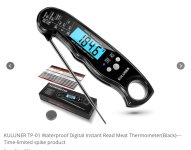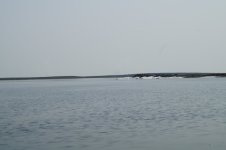While paddling, PPine and I both carry thermometers. This got me to wondering who carries thermometers, and what kind.
I use a meat thermometer, but it's never been in the kitchen. It folds and fits into a pocket on my PFD. On the water, I was Mr. Smarty Pants telling other paddlers the water temperature. This one just fits in a PFD pocket, turns on automatically when you unfold the probe, says it's waterproof, and it even has a little button to change the readout to "speak Canadian," you know, Centigrade, like in the rest of the world.

Do you carry a thermometer?
I use a meat thermometer, but it's never been in the kitchen. It folds and fits into a pocket on my PFD. On the water, I was Mr. Smarty Pants telling other paddlers the water temperature. This one just fits in a PFD pocket, turns on automatically when you unfold the probe, says it's waterproof, and it even has a little button to change the readout to "speak Canadian," you know, Centigrade, like in the rest of the world.

Do you carry a thermometer?



